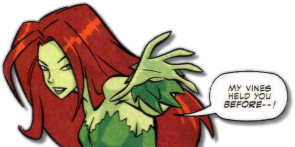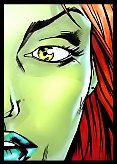 Poison Ivy
Poison Ivy
- Poison Ivy

Sequential art may be abridged or rearranged; for the full version, please turn to the original comics.
May contain spoilers.
- A Touch of Poison Ivy. (1966)
-
Ivy's first appearance
establishes her attraction to the Batman. Her original look was based on that of Bettie Page*.
- Black Orchid. (1989)
-
After Crisis*,
Ivy is first reintroduced in Neil Gaiman's Black Orchid.
We meet a dark, helpless, hopeless Ivy
in a supporting role, Gaiman's writing nicely complemented by
Dave McKean's unorthodox visual rendition.
The combination sent a shiver up my spine, and I'm almost happy this is
not how we usually see her, devoid of hope, looking almost like a stone
statue, cold and hard, a gargoyle rather than a topiary.
- The Poison Tomorrow. (1992)
-
This story brings Batman and Green Arrow together, trying to uncover
one of Ivy's plots. And yet once more, we get a
different look for Ivy —
and no, I don't know what the
marks under her eyes are, either.
The Poison tomorrow foreshadows the later Contagion, with Ivy trying to cull those pesky humans for the good of the planet, hoping to set herself up as a new Eve.
- Hot House. (1993)
-
Hot House brings us a nuanced plot about
love,
obsession and
redemption, and Pamela with a more
rigid look that rather surprisingly
I really appreciate and am tempted to describe as New England
for some reason. Once more,
the Batman is affected by her presence,
and as things get trippy, the art
changes to reflect that, sometimes
crossing the line that divides the daring from the outright cheesy.
- Year One. (1995)
-
In their (retold after Crisis*) first encounter, a mutual
attraction between Poison Ivy and the
Batman is obvious right from the start.
With passions such as theirs, and conflicting ones at that, things can but go up in flames in the end...This is a classic blackmail-the-rich scheme.
- Passion's Fruit. (1997)
-
While I'm not too happy with the way the characters came out (I'm a sucker
for physically beautiful characters, in case you hadn't noticed, particularly
where my favourites are concerned) in Hamner's and Campanella's art, their
portrayal in Andy Helfer's story is dead on and creates an interesting
simile, that of chatelaine Ivy sitting in Arkham Castle waiting for her dark knight to come home.
- A Walk in the Park. (2000/2001)
-
After the No Man's Land and all the good she did feeding the
hungry and saving the children, the Powers that be try to
evict Ivy from Robinson Park.
This is one out of a sequence of issues that achieve a very distinct look by choosing just two spot colours (in addition to the obligatory black and white) and sticking to them throughout the whole issue, the only variety introduced by using the first colour more prominently on some pages, and the second on others. This works surprisingly well. - Both Sides Now. (2002)
-
While the Harley Quinn series brings us art in a variety
of styles, issue #16 must be mentioned as outstanding. Jimmy Olsen and
Harley Quinn both recount a series of events; Harley's version is drawn
by one penciller (in a rather
mangaesque style), Olsen's by another,
and the background story by yet a third.
Another honourable mention goes to issue #19 for the "new look" — Ivy temporarily trades the "swimsuit" look for a "bikini."
Story-wise, the early issues of Harley Quinn explore the relationship between Poison Ivy and the Joker's ex girl-friend who she physically enhanced during the No Man's Land story arc, originally both out of compassion for another woman wronged by the man she loved beyond everything, and in the hope of attaining a "wildcard" in her truce with the Batman.Ivy doesn't get to save a lot of trees here; this is Harley's comic, and often, Ivy grudgingly gets dragged along into Harley's joyrides and small-time robberies. - Hush. (2003)
-
Hush gives us a tour de force through the
Batverse, visiting, sometimes reinventing all major players, portraying
them in the distinctly
superheroic,
larger-than-life
art of Jim Lee. If you like your leading roles to look like
supermodels, this is the Ivy for you.
While this displays a revenge-motif that was overdue after Cat-a-clysm*, it also shows that Ivy isn't necessarily above making money, should the opportunity arise.
- Cast Shadows. (2004)
-
Cast Shadows*
is a
beautiful story*
that elaborates on the
relationship
of Ivy and Batman — both with each other and themselves.
The story has a beautiful Romeo and Juliet moment when — assuming Batman dead — Poison Ivy tries to kill herself.In the end, Poison returns to Arkham to finish her rehabilitation, but some "anonymous benefactor" makes sure her time there isn't as daunting as it might have been.The art plays with the titular light/shadow motif and dances between "inspired" and "l'art pour l'art". While John van Fleet largely succeeds in presenting attractive images, he mostly fails in presenting physically attractive characters. That said, the book is well worth reading as the story is one more likely to stay with you than most of the Ivy ones.
- The City Is... (2004)
-
In the relatively recent Batgirl issues,
The City is a Garden and
The City is a Jungle,
we meet a green Poison Ivy (with shoulder-length hair less curly than
that envisioned by Jim Lee) in a two panel-sequence that seems to
perfectly sum up years of being
in lust with the Batman.
Another reclaiming-the-city plot.I'd have preferred a more morally ambiguous story, where the Eden Ivy creates actually makes people happy rather than pitting them against each other.
- Human Nature. (2005)
-
Human Nature affords us a look at
Ivy's softer and, dare we say it, more human side,
as it catches up on the lives of
the orphans she took care of during the No Man's Land. The art ranges from
brightly coloured heroic
with clear inking (and sometimes slightly exaggerated expressions, if not
nearly as bad as in Batman: Harley Quinn or the abominable
Danger Girl) to much softer, almost water-colour-like flashback
sequences to almost "tribal" images with a distinct "woodcarving" feel in
some panels.
- Gotham Girls/Adventures.
-
The ... Adventures (Batman Adventures etc.)
titles as well as the Harley and Ivy and
Gotham Girls miniseries were created as tie-ins for the
popular Batman
animated series. These titles are generally
more playful (sometimes to the point of being
funny) than the original
comics. While Batman Adventures featured the
fair-skinned Ivy
from The Animated Series,
the other lines —
Gotham Girls,
Harley and Ivy
and Batgirl Adventures used a
verdant, slightly mangaesque Ivy
that seems to combine Jim Lee's green-skinned Ivy with the style of the
The New Batman Adventures.
- The Batman. (2004)
-
The new animated series, The Batman, shows an all-new
interpretation of the character. Not as openly sensual as her previous
incarnation in The Animated Series, the
Ivy from The Batman
was obviously designed to put more emphasis on "plant" side of things,
her hair reminding one of the petals of a rose, making her
"look like a pretty flower."
- To do...
-
Mug shot.
Poison Ivy created by Robert Kanigher, ©1966 by DC Comics. This is a fan-site and not affiliated with DC.